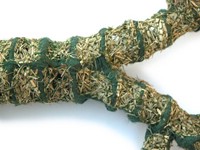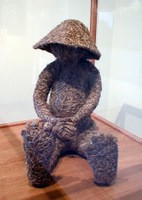


The images show one of the stone baskets, they were quite delicate. There is a type of grinding stone where a basketry upper is placed onto the stone and then the flour etc was saved, the basketry piece would then be removed and the stone left bare. In my apttempts I actually fastened the first row of fibre onto the stone and coiled up from there.. it was an invention of using what was at hand.
The colured wool basket shows some of the plant dyes I extracted from leaves and barks whilst camped. Another way of understanding "nature". Eileen Keys , the potter, was so excited about my journey she urged me to try plant dyes, she was to elderly to camp anymore. She was well know for the use of minerals mixed in with her clay and then she started to dye wool with leaves, barks and minerals.
The coiled string vessel has various bits of iron collected from old mine sites, I coiled rope and string in quite organic shapes to accomodate them.
Looking at them one could hardly call them baskets, more like fibre pots. The influence of the shapes of freestanding granite rocks are obvious. All my life I have been visiting granite rocks so small wonder that I am insired by them.
There is always a problem if one doesnt move along, One can be worked into a corner, particularly if there is an inherent charm in a material. So I moved from adding found discarded metals to plant dyed wools to using native plant materials.
I am looking forward to seeing where Lorraine goes after her billy cans / dilly bags. They occupy an interesting position.
With regard to using Aboriginal language words in my work as titles, descriptions etc.
When I do use language it is often because it seems more appropriate, considering the history of the piece, perhaps Mary has referred to it as that or I have used something which touches that part of life. Plus it throws up a bit of a mystery, makes people realise that is there a huge gap in our 'whitefella way' of being. Notice how many people set about to learn French or Italian when they travel overseas, imagine if we did the same when we travelled in this country.WOW.
( A superb Ngaanyatjarra/ Ngaatjatarra Dictionary can be purchased from
)
Thrums...
There was a weavers pardise in Perth up until mid 1980s. The Village Weaver, and one whole wall of shelves was filled with thrums. Off cuts from the carpet making factory that used to exist in Albany at the Albany Woolen Mills, Alas all a thing of the past. The thrums were a glorious mess of tangled skiens, they suited me, they were strong, I could just cut into them and they were earthy colurs plus neutral so they could be dyed.
The music idea is absolutely right, singing is major part of Marys painting and I have adopted the practice as well, friend Kopi has composed music around fibre pieces. The rythym of stitch, the flow of form, its a thrum of input, a type of mental dance.
The women at Blackstone sing very often when they are stitching. When Kantjupayi was making her kalaya (emu) she burst into a kalaya song to sing the lifespirit in. There she was waving the grass piece up and down, the other women stopped what they were doing and started beating time with clapping their hands between their thighs, its a womans way.
The kalaya came to life just like that. Combining the auditory and the visual it became whole.
Everything one makes should have that life in it, no matter what.
Sharing making, well that is a stage one needs to pass through. The idea of not owning the process, not the out come, but the process.. we are very precious about process. Notice how a teacher is criticised if they touch a student work.
I have often commenced something and just left it knowing that somebody needs to pick it up and they will. The echidna was well under way when a young woman walked along and picked it up. She worked on it for about half and hour, put it down and then I picked it up again, we both learned about life from each other through that experience, I dont think we said more than a few words, it wasnt necessary. (The echidna is now at the Womens Centre in Blackstone for all to see.)
What all this shows is the treasure of how making is part of the whole of life, it is not a separate issue, the rewards are so varied because of the interaction with others, with places and materials
The comittment a person should make right from the beggining to learning a fine craft is very important, to have sense of what you are entering, to take advantage of the periphery not just the centre. To physically take the opportunity to place yourself for potential experience. It is good to be a clever designer but you also need the spirit of life in what you make, its what gives your efforts a uniqueness and a language of your own.
 The Malian director Abderrahmane Sissako talks about his new film Bamoko and its impact in the west:
The Malian director Abderrahmane Sissako talks about his new film Bamoko and its impact in the west:








